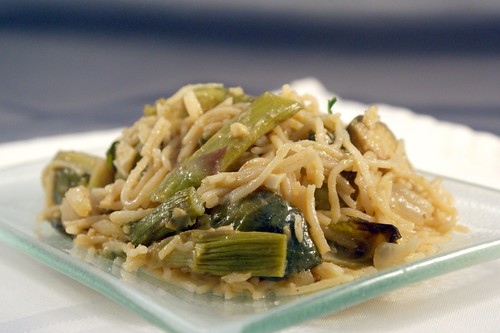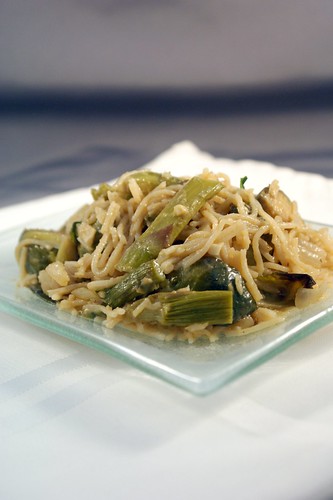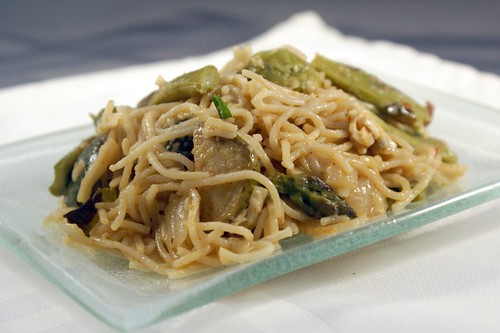So why do I waste my time? Because it’s fun and rewarding! Because I like knowing there’s nothing in my bread except flour, water, salt, and yeast. And because I don’t always have access to a good bakery! So while I won’t say bread isn’t an undertaking, I will say if it’s something that interests you, you should give it a go. It takes time to perfect, but not necessarily prone to disasters of epic proportions. The trick is finding someone to walk you through it. This is where Nicole of the wonderful Pinch my Salt comes in. She’s posted a plethora of bread recipes, always with great step by step pictorial instructions and lessons to learn. Essentially, she makes bread baking a whole heckofalot less scary.
Back in September Nicole posted a day by day set of instructions for how to create your own wild yeast sourdough starter. From scratch! Using just water, flour, and a little pineapple juice to start. In case you’re wondering the pineapple juice is used because the acidity helps the right kind of bacteria to grow, which is what the wild yeasts come to the party to eat. Err, or something like that...?
Good thing I had already decided to take the plunge and my starter was already under way! I am now the proud owner/parent of my very own sourdough starter. I grew/birthed it myself! It did take a couple of tries, and it was touch and go there for awhile, but I think we’ve ultimately reached a delicious understanding. I feed it - it feeds me. Here are some lessons I learned in my failed and almost failed attempts (most of it either wisdom directly from Nicole or online resources pointed out to me by Nicole - she rocks!):
- It’s easier to create a starter with whole wheat flour instead of refined flour because the sugars in the whole wheat provide more food for the yeasts to feed off of.
- If your starter is a bit sluggish at the get-go, it can be helpful to stir it once a day or so, just to redistribute stuff.
- After day 5 or so, when you’re feeding it twice a day, it helps to move to a scale. Measure 8 oz. of starter and mix in 4 oz. flour and 4 oz. water. And make sure your water isn’t too hot or cold or you’ll kill/scare away your yeasts.
- When you’re ready to move your starter to the fridge, cover it in plastic wrap with a few holes poked in it. That way the yeasts can breathe, but the blob won’t dry out.
- When adding your starter to recipes, 1 cup of starter can replace approximately 1 cup of flour and ½ cup of water in the recipe.
So while my lame ineptitude prevented me from having the foresight to get a money shot of these babies - the one where you see yolk running from the center like an erupting volcano - I did remember to write down the method to my madness, so you can give it a go and see the insanity for yourself. You’re welcome. Doughvember, for the win!
PS: Why yes, I am addicted to instagram. Feel free to follow me at bananasforbourbon!
Pumpkin Ravioli (with an egg yolk - surprise!)
Makes 8 raviolis (these are rich, so I would say that’s more than 2 portions)
~ ¼ batch of this recipe for sourdough pasta dough
1 large shallot, finely chopped
4 cloves of garlic, minced
6-7 leaves of sage, minced
1 TB olive oil
pinch of kosher salt
¼ tsp ground black pepper
¼ tsp ground nutmeg
½ cup white wine
1 cup pumpkin puree
¼ cup pistachios, lightly toasted and cooled
¼ cup Parmesan cheese
lemon juice (optional)
8 egg yolks
- In a small saucepan, heat the olive oil over medium heat. Add the shallots with a pinch of salt and saute until softened, about 5 minutes. Add the garlic and cook for a minute or two to soften. Add the pepper and nutmeg and stir to incorporate. Add the wine and bring it to a simmer. Once the wine has reduced by about half, or a little more, remove it from the heat and let it cool.
- In a food processor, finely grind the pistachios. Add the pumpkin puree, Parmesan cheese, and the cooked shallot mixture. Process until the mixture is smooth. Adjust the seasoning to your taste. Add a little lemon juice if it needs some brightness. Add the mixture to a ziplock bag (or pastry bag if you want to be fancy), and cut the corner so you can pipe it.
- Roll out the pasta dough into very thin sheets. I don’t have a roller, so I did it by hand. You’ll need about a 4 inch square to work with. Pipe the filling in a circle, leaving about an inch-wide circle of open space in the middle (about the size of your egg yolk). I didn’t measure, but I’d say it was about 1-2 TB of filling. Basically, you want about ½ inch of thickness and ½ inch of height for the filling, or about the level with the yolk. Carefully place an egg yolk in the middle of the filling. Place a sheet of dough on top and gently press around the filling, sealing it as tightly as possible. Then press a little firmer to make sure the dough it good and sealed. Cut out the ravioli with a glass, a biscuit cutter, or just a knife. I opted for about ¼ - ½ inch between the edge and the filling. Repeat this for as many ravioli as you want to make.
- In a pot of gently simmering water, add the ravioli. Make sure the water doesn’t boil too hard, or you raviolis could fall apart, and make sure it’s not set too low or once you add them, it’ll take too long to come back to a boil. Boil the ravioli for 4-5 minutes, depending on how runny you like your yolks.
- Remove the ravioli from the water, and add them to whatever sauce floats your boat. I did a simple olive oil drizzle (with good olive oil), since the yolks are essentially all the sauce you need, but I’m sure tossing them with some browned butter and sage would be divine too.










